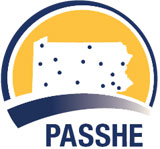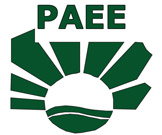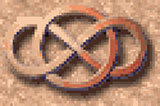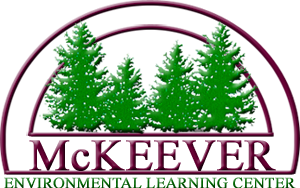Sustainable Practices
Wind Energy

The wind energy system was completed June 1, 2007. The installation consists of a 10kW Bergey Excel-S wind turbine mounted on a 140-foot guyed lattice tower. This is a grid-direct system meaning that the wind turbine ties directly into the existing utility service. When the system is producing more than the building is using, the excess power is fed back into the utility for credit. This wind energy system provides supplemental power to the McKeever Center.
Our primary wind is from the southwest and the annual wind speed is 10.1 – 11.2 mph. On average, the wind turbine generates about 170-220 kWh’s per month, with highest production occurring during the fall, winter and spring.
The inverter and kWh meter are the only balance-of-system components for this wind turbine. The inverter is the device that changes the electricity produced by the turbine into usable electricity. The inverter also makes it possible for the wind energy system to legally run in parallel with the existing utility grid. The kWh meter allows us to take monthly readings and track the production of the wind turbine. The meter also provides an early warning for any problems the system may have.
Solar Water Heating System

This solar application consists of the installation of six (6) solar collectors, each 4’ x 8’ on the southern exposure roof of the dining hall and two (2) 110-gallon storage tanks equipped with internal heat exchangers. This project includes a complete and operational system to provide solar heated water as a preheat to the existing electric water heater. This system is designed to provide 28,000,000 btus/year based on 325-gallon/day usage 6 days per week, providing 45% of the load.
As a preheat system, water circulates through all six panels. Depending on the amount of available sunlight, this heated water goes into the hot water tanks and then on to the sinks in the kitchen/food preparation area and the industrial dishwasher. We have seen water coming into the storage tanks as high as 200 degrees Fahrenheit. At times, the water is so hot, we installed a mixer or diffuser so our food service workers would not be scalded by hot water. This system was installed April 2009.
Geothermal Heating/Cooling Systems

McKeever’s two (2) retreat houses are equipped with geothermal heating/cooling systems. This system consists of an electric ground source heat pump located in the basement of each house and two (2) 150-foot wells. Heated or cooled air is transferred to rooms within the house via forced air ductwork.
Ground source heat pumps (GSHP) are electrically powered systems that tap the stored energy of the greatest solar collector in existence: the earth. These systems use the earth’s relatively constant temperature to provide heating, cooling, and hot water for homes and commercial buildings.
Ground source heat pumps can be categorized as having closed or open loops, and those loops can be installed in three ways: horizontally, vertically, or in a pond/lake. Our houses are equipped with the horizontal closed loop system because the area around both houses is primarily forested. The type chosen depends on the available land areas and the soil and rock type at the installation site. These factors will help determine the most economical choice for installation of the ground loop.
For closed loop systems, water or antifreeze solution is circulated through plastic pipes buried beneath the earth’s surface. During the winter, the fluid collects heat from the earth and carries it through the system and into the building. During the summer, the system reverses itself to cool the building by pulling heat from the building, carrying it through the system and placing it in the ground. This process creates free hot water in the summer and delivers substantial hot water savings in the winter.
Open loop systems operate on the same principle as closed loop systems and can be installed where an adequate supply of suitable water is available and open discharge is feasible. Benefits similar to the closed loop system are obtained.
Compact Fluorescent Bulbs
Compact fluorescent bulbs use 66% less energy than a standard incandescent bulb and last up to 10 times longer. Compact bulbs are cool to the touch and do not give off heat. All of our buildings are now equipped with compact fluorescent bulbs/lamps and T-8 electronic ballasts.
Low-E High Performance Windows
Our office building and both retreat houses have these types of windows (low E), which stand for low emittance. Low-E coatings are microscopically thin, virtually invisible, metal or metallic oxide layers deposited on a window or skylight glazing surface primarily to reduce the U-factor by suppressing radiative heat flow. The principal mechanism of heat transfer in multilayer glazing is thermal radiation from a warm pane of glass to a cooler pane.
Coating a glass surface with a low-emittance material and facing that coating into the gap between the glass layers blocks a significant amount of this radiant heat transfer, thus lowering the total heat flow through the window. Low-E coatings are transparent to visible light. Different types of Low-E coatings have been designed to allow for high, moderate or low solar gain.
Composite Lumber

Composite lumber is made from a combination of reclaimed wood and recycled plastic. The lumber will not rot or deteriorate due to harsh weather or insects. It contains no toxic chemicals or preservatives and resists moisture. McKeever’s deck and picnic tables adjacent to the dining hall are made from plastic lumber as well as decks attached to the retreat houses. Our new bunk beds in all three lodges are made from composite lumber. Other uses of this recycled material include the raised beds and flower containers in the butterfly garden and many of our educational materials used in the programs.

Recycled Carpeting
Carpeting in the library and throughout the retreat houses are made from recycled plastic bottles. Recycled carpet is of equivalent price to other carpets and provides for better indoor air quality. There is no off gassing with recycled carpet. The use of plastic bottles keep these materials out of the landfills.
Natural Flooring

Throughout the retreat houses, indoor classrooms and conference room you will find a type of linoleum that contains no synthetic materials. Instead, this beautiful flooring is made from a renewable resource – wood! The flooring is composed of wood and cork flour, limestone and linseed oil and natural pigments. This floor is easy to clean and maintain.
Solatubes
Solatubes bring natural daylight into interior rooms. This system consists of a clear dome that collects sunlight into a highly polished and reflective tube that reflects the light down to a diffuser on the ceiling.
No VOC Paint
Volatile Organic Compounds (VOC) are emitted as gases from certain solids and liquids and include a variety of chemicals, which may cause short and long term adverse health effects. No VOC paint reduces toxins for people improving indoor air quality. No VOC paint has little to no hazard fumes and cleans up easily with soap and warm water.
Natural Landscaping

Natural landscaping or native gardening is the use of plants which are indigenous to a certain area in place of groomed lawns and mowed areas that blend a specific area into its natural surroundings. There are many benefits of natural landscaping, including low maintenance, no pesticides, herbicides or fertilizers and economical savings by less mowing.

Native plants also provide habitat for native species of butterflies, birds, insects and wildlife in general. Native plants increase the biodiversity of a given area and replace invasive plants that are not native to the area. McKeever has a number of areas where we stopped mowing. We have turned these areas include butterfly gardens, vegetable gardens and areas designed specifically for wildlife habitat improvement.
Subscribe to the McKeever Newsletter
Links
 Slippery Rock University
Slippery Rock University of Pennsylvania – A Rock Solid Education
Slippery Rock University
Slippery Rock University of Pennsylvania – A Rock Solid Education PA State System of Higher Education
Let a state system university be your answer.
PA State System of Higher Education
Let a state system university be your answer. Pennsylvania Association of Environmental Educators
PAEE unites, supports, and empowers a community of Environmental Educators throughout Pennsylvania.
Pennsylvania Association of Environmental Educators
PAEE unites, supports, and empowers a community of Environmental Educators throughout Pennsylvania. EnviroLink Network
Non-profit organization providing access to thousands of online environmental resources.
EnviroLink Network
Non-profit organization providing access to thousands of online environmental resources. GreenTreks Network, Inc.
Telling Stories that Change the World
GreenTreks Network, Inc.
Telling Stories that Change the World PA Fish and Boat Commission
Protect, conserve, and enhance the Commonwealth’s aquatic resources and provide fishing and boating opportunities
PA Fish and Boat Commission
Protect, conserve, and enhance the Commonwealth’s aquatic resources and provide fishing and boating opportunities Mercer County, PA
Everyone needs an escape plan.
Mercer County, PA
Everyone needs an escape plan.
